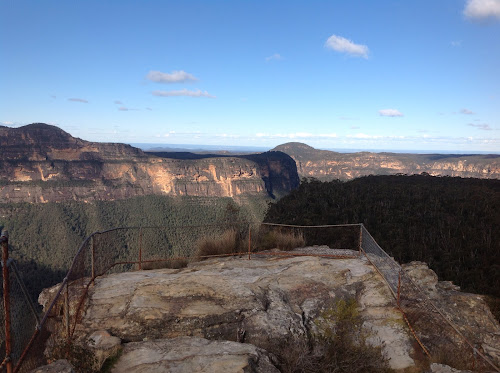arboretum
— noun, plural ar·bo·re·tums, ar·bo·re·ta [ahr-buh-ree-tuh]
A plot of land on which many different trees or shrubs are grown for study or display.
Not having done Latin at school I wasn't absolutely sure of the definition of arboretum but the dictionary entry, (above) states exactly what the National Arboretum is: a collection of trees of trees for display and study. On Tuesday we visited this new national treasure. An arboretum was in the very original plans for Canberra when it was first drawn up but it never eventuated. The fires in 2001 destroyed the pine forest that was on the original area that earmarked for this project so in 2002 a committee was set up and plans were developed. What we saw is a very new arboretum that is all planted but it is very much in its infancy. There are a hundred forests and trees from all around the world. There are many of each species so that a feeling of being in a forest of each species should be able to be achieved. Some plantings are also on both sides of the roads or the trails. (There are both walking and biking trails as well as a road that links around the entire grounds. The information centre or Village Centre as it is known, opened earlier in the year and it contains a wealth of information, as well as volunteer guides. Included at the Village Centre are also two displays - one is the Discovery Garden that you can learn about waterwise gardens using Australian plants, and the other is The National Bonsai Collection. Large scale artwork is also an integral part of the whole site and it is great to see it included.
 |
| View from Dairy Hill looking across to the CBD of Canberra. |
 |
| Another view from Dairy Hill. This time looking across the Village Centre to the Himalayan Cedars. |
 |
| One piece of large scale art work. |
There are two areas that are somewhat established - the Himalayan Cedars and the Cork Oaks. These tree were planted at one end of what was to become the arboretum back in the 1920s. The cork oaks were discovered to be financially viable and have a harvesting programme in place. To walk through 'this forest' makes you feel you could be easily in the Mediterranean. The Himalayan Cedars were also planted at this time and although half of these trees feel victim to the bush fire. More have been planted and those that remain are certainly doing well.
 |
| Cork Oak forest - note where the bark has been harvested. |
 |
| The Himalayan Cedars. |
Fire remains a constant for those responsible for the management of this resource and every endeavour has been taken to reduce the risk. This includes water storage with pumps and hose connections everywhere, tracks, legume plantings under the trees and varying the groupings of trees with shorter growing ones next to the higher growing ones.
In years to come this will be a magnificent place to visit and we feel lucky to have been able to visit it in its infancy. This link will take you to the website where lists of all the trees are available, as well as visitor information. http://www.nationalarboretum.act.gov.au/
Next stop was the National Botanic Gardens. These gardens contain only Australian plants which was very interesting for us to see. I think it was good we went at the end of our holiday as having spent a lot of time out in the bush we were ready to identify many of the plants we had seen. To start with many of them all look the same and it isn't until you get you 'eye' tuned in that the diversity can be appreciated. These gardens are well laid out and all the plants are labeled. Once again there is a very good information centre, where both guided and self guided tours can be taken. Special trails are set up at different times including the 'plants in flower now' trail.
We arrived in time to have some lunch before setting off on our walk. If you are ever in Canberra this is also a very good place to visit and this link will give you further information. http://www.anbg.gov.au/gardens/
 |
| In the rain forest. |





































